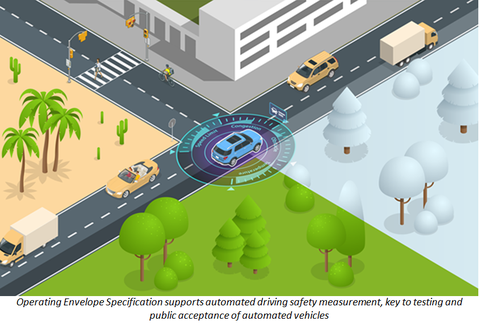Summary
Automated vehicles (AVs) will significantly impact our daily lives and improve the competitiveness of our economy. Advances in communications capabilities – for wired and wireless onboard networks and offboard communications with other vehicles, infrastructure, and services in the driving environment – can drive innovation in vehicle automation. Measurement science and standards, including for AV communications, are essential to supporting safe and predictable operation of AVs and increasing consumer confidence. This project brings together expertise from the Communications Technology Laboratory to address AV system integration and communications challenges, in collaboration with the NIST-wide Automated Vehicles Strategic and Emerging Research Initiatives (SERI) program.
Description

Operating Envelope Specification supports automated driving safety measurement, key to testing and public acceptance of automated vehicles
Automated vehicles (AVs), or Automated Driving Systems-equipped (ADS-equipped) vehicles, have great potential to improve our lives by freeing us from the stress of driving and reducing accidents caused by distractions or poor judgement. Connected, reliable, and safe AVs will spark significant improvements in our transportation systems and infrastructure and promote economic growth and innovation. Much effort is needed to realize this vision, including NIST activities to advance measurement methods and standardization to support AV development, operations, communications, and safety, in collaboration with our stakeholders. (See NIST Taking Measures blog “Cruising Toward Self-Driving Cars: Standards and Testing Will Help Keep Autonomous Vehicles Moving Safely on the Road” for additional context on NIST efforts to support automated vehicles.)
The safe and predictable operation of an AV depends on communications. A vehicle’s awareness of its operating environment and ability to react to unsafe operating conditions depends on the communication networks both within the vehicle and between the vehicle and other entities (vehicle-to-vehicle V2V and vehicle-to-everything V2X communications). All vehicle subsystems, including the sensing and perception systems and artificial intelligence that support vehicle decision making, depend on communications to interconnect with each other. Communications also enable automated driving capabilities such as cooperative perception, cooperative driving, remote vehicle management, and teleoperation. Equally importantly, AVs are not isolated entities and must be integrated into the Internet of Things (IoT) infrastructure of our cities and communities such as transportation systems. Communication plays a foundational role in enabling such integration, and a connected system view is essential to understanding and advancing driving automation.
This project is organized into two major areas: AV system integration, and AV communications. The first area (AV system integration) involves ongoing collaboration and coordination with the broader NIST SERI AV team to investigate AV behaviors, define appropriate driving scenarios including communications, and develop methods for assessing overall AV system performance and safety. This effort includes coordinating NIST AV research in areas of communications, sensing and perception, risk management of artificial intelligence, and cybersecurity. As part of this effort, this project is contributing to the architecture design and development of the NIST AV systems interaction testbed, which will provide an environment to measure the impact of perturbations to AV systems on the performance of the vehicle as a whole. The second area (AV communications) includes identifying AV communications scenarios (including on-board and off-board), evaluating AV communications requirements, developing relevant network modeling capabilities, and integrating network models into a co-simulation environment that simulates the integrated vehicle behavior including with respect to safety.
Project tasks include:
- Support SERI AV project objectives including a NIST workshop and stakeholder outreach, and engage with SERI research efforts on communications and other challenges
- Identify, select, and define relevant automated vehicle behaviors (with SERI team) and evaluate impact of advanced communications technologies on behavioral competencies
- Identify and model AV communications scenarios
- Demonstrate use of Operating Envelope Specification (OES) in safety measurement of automated driving systems
- Develop measurement methods for teleoperation and advance standards for enabling advanced teleoperation capabilities
This project engages with stakeholders broadly, including through the NIST-led ADS Safety Measurement Technical Working Group; organizations such as SAE International and the Teleoperation Consortia; and in coordination with other Federal agencies such as the U.S. Department of Transportation and its National Highway Traffic Safety Administration.

